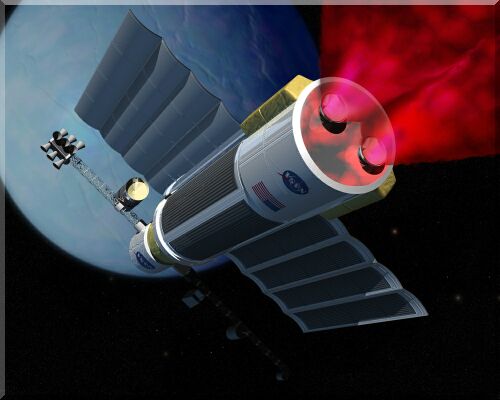Antimatter: Microfusion Drive
Antimatter Initiated Microfusion (AIM)
As with the ACMF drive, the Antimatter Initiated Microfusion (AIM) drive also uses antiprotons to initiate a fission reaction that in turn ignites a fusion burn. However, the actual method proposed for the AIM drive is significantly different from the ACMF drive. It would produce more power overall, and require more antiprotons. What follows is a discussion of the AIM drive concept, and then a brief overview of the AIM Star space probe that is being designed to use the AIM drive.
As mentioned in the overview of Antimatter Drives, the world's production of antimatter is abysmally low. Currently it is on the order of 1 to 10 nanograms per year. While antimatter has a tremendous energy density, this is still completely insufficient for a pure antimatter/matter reactor drive. That rules out manned interstellar travel using antimatter drives in the near future. However, a hybrid between antimatter and nuclear drives would allow humans to explore their own solar system with reasonable mission times and costs. One of the two hybrid designs is the AIM.
As with the ACMF, the AIM is being developed by Penn State University. "Sparking" a fusion burn has been a major problem for the past 50 years. Scientists today feel that they are close to breaking even (getting as much, or more, energy out of the reaction as is put in to start it). Researchers at Penn State, however, propose that injecting small fusion fuel droplets into a cloud of antiprotons confined in a small space would produce the desired fusion reaction. This is the bases for the AIM drive concept.
The AIM drive has a four step cycle, figure 8 gives a rough idea of how the engine cycle would work:
First, 100 billion antiprotons are placed in a potential well generated by electric and magnetic fields [1]. Next, a 42 nanogram droplet of Deuterium and Helium-3 is injected into the reaction chamber, additionally a small amount of U-238 is allowed to collide with the surface of the antiproton cloud [2]. The annihilation of the antiprotons with the U-238 induces rapid fission that fully ionizes the Deuterium/Helium-3 fuel into a plasma, this plasma is compressed by the potential well as it undergoes nuclear fusion for 20 milliseconds [3]. The potential well is then relaxed to its original configuration, 100 thousand antiprotons have been annihilated [4]. This process is then repeated 50 times, and a new batch of antiprotons is then inserted into the engine.
Phase 3 of the engine cycle shows the antiprotons and the nuclear fuel being trapped on opposite sides of the potential field. This is possible because the antiprotons are negatively charged, and the nuclear plasma is positively charged.
This drive concept is newer and less developed then the ACMF, but has been deemed by NASA as a possible drive concept for an unmanned space probe mission to the Oort cloud. Currently several major issues with the AIM drive must be addressed before it could be successfully used. Besides the antimatter production and containment problems that exist for the ACMF also, the AIM additionally has problems with the ion densities required in stage 3 and instabilities in the potential well. Again, these problems are technological problems, and therefore will most likely be overcome.
A preliminary design for a spacecraft that would use the AIM drive concept has been developed by Penn State University. It is called AIM Star and would be intended for long range unmanned missions. An example of such a mission would be visiting the Oort cloud (10,000 times farther from the Sun than Earth is) within 50 years. Many technological challenges must still be overcome before a spacecraft like AIM Star can become a reality, however, PSU researchers are confident that these problems can be resolved.
Below is a rendering of what the AIM Star probe might look like if built:

Picture obtained from
LEPS site
The AIM Star probe consists of an AIM "booster rocket" pushing a scientific payload. The payload would be undeployed during the first stage of the mission. The AIM drive would fire constantly for 22 years, accelerating the craft to 0.003 times the speed of light. At this point, the main drive would disconnect from the payload, and the payload would deploy to allow communication with Earth.
The probe would then coast the rest of the way to, and through, the Oort cloud taking measurements as it did so and sending the data back to Earth. Below is a rendering of what the scientific payload would look like once deployed and detached from the AIM drive:

Picture obtained from
LEPS site
Using Deuterium/Helium-3 nuclear fuel, the probe would require 28.5 micrograms of antimatter to perform its mission. This is significantly more antimatter than is required for the ICAN-II spacecraft, but AIM Star would be traveling a much further distance. The required amount antimatter may well be available by the time that the other engineering challenges facing the AIM Star project are resolved.

